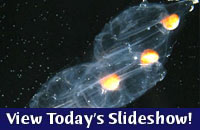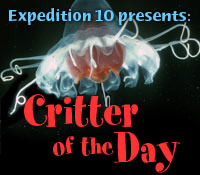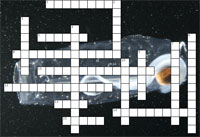|
Try the interactive puzzle » February 26, 2006 by Kate Madin At 2 a.m., University of Tokyo biological oceanographer Jun Nishikawa was too excited to sleep. His heart was beating fast. “This is very new!” he said. “We are the first people to ever see this.” He had just witnessed a new way to ‘see’ what transparent plankton do, deep under water. For years, Larry Madin and Erich Horgan worked with WHOI engineers to design what for them would be a dream instrument—a towed camera capable of watching gelatinous creatures at any depth. Last night, they and engineer Josh Eaton tried a test run—and it was a great success. “I first had the idea 20 years ago to have a camera you could tow, to see transparent jelly animals,” said Larry. “Finally we got a grant, spent a couple of years trying different things, and ended up with this instrument. It’s big, and looks kind of ugly, but the important thing is, it works!” The Large Area Plankton Imaging System, or LAPIS, projects a thin square of light in the water, like a lit-up window. When fragile plankton swim through the light, a camera captures clear images of their natural behavior in the water—without causing turbulence that disturbs them, as other towed systems do. “We’ve worked on this a long time, and created something no one else has done,” Erich said, “and there’s a huge need to be able to see what these animals do down deep without disturbing them.” Jellies can be caught in traditional plankton nets, which collect from a big enough volume of water to allow estimating population size at any depth. But they are forced by the water flow into the container at the narrow end of the net, and are often smashed. It becomes impossible to know their behavior. Scuba divers can collect jellies by hand, in jars, to obtain healthy animals to observe. But they see too small a volume of water and must stay too shallow to understand how plankton act below the divers’ limits (about 30 meters, or 100 feet). LAPIS samples large volumes in deep water, and captures picture of how plankton behave. “Before LAPIS, we couldn’t see live salps swimming at 200, 300, or 400 meters,” Larry said. “Now we’ll have a much better idea of what live plankton do.” “This job has been fun, and presented unique challenges. And I never have to touch the plankton—it’s perfect!” said Josh, a true engineer. “I already have the next version in mind—streamlined.”
|
|||||||||||||||||||||||||||||||||||||||||||||||||||||||||||||||||||||||||||||||||||||||||||||
Mailing List | Feedback | Glossary | For Teachers | About Us | Contact
© 2010 Dive and Discover™. Dive and Discover™ is a registered trademark of Woods
Hole Oceanographic Institution





